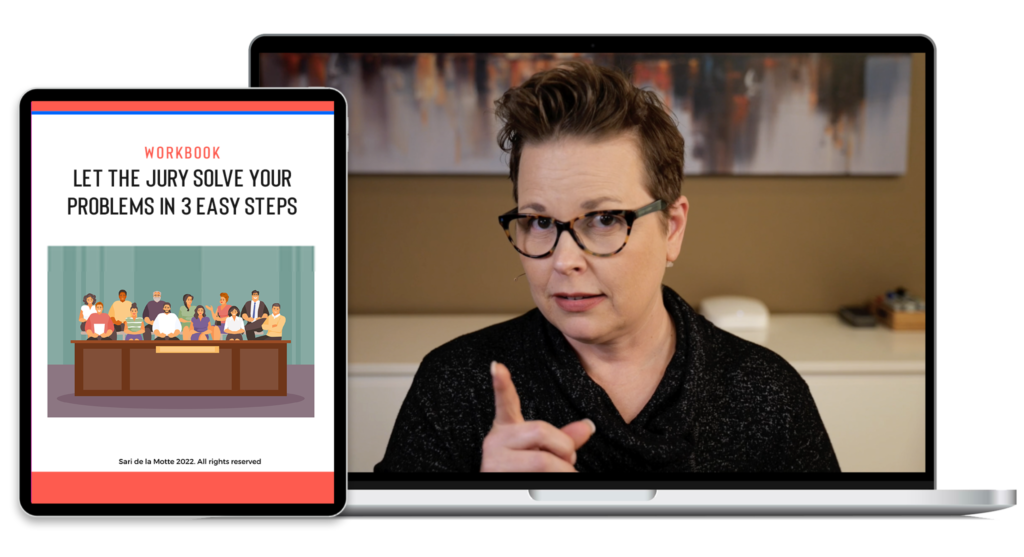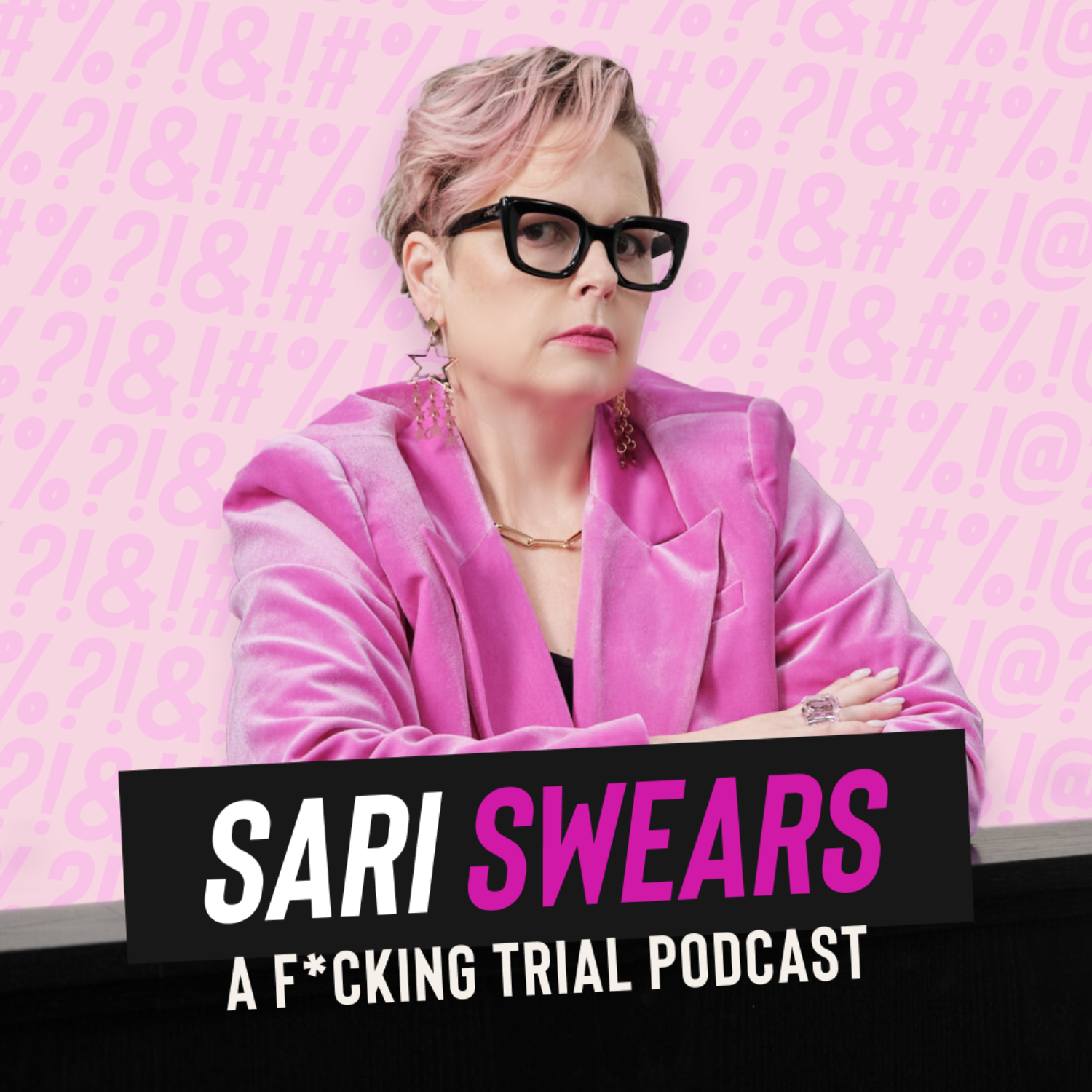Your brain’s job? To keep you safe.
Your job? To lead anyway.
Most of the fear you feel in trial is fake news — just recycled thoughts about losing, judgment, or not measuring up.
But here’s the kicker:
Your thoughts aren't facts, and you can rewrite them.
This week’s episode hands you the tools to:
💣 Ditch the vague labels and call it what it is: dread? shame? rage? Name it to tame it.
💣 Sit in the suck and breathe. Stop numbing out and start showing up.
💣 Trade panic-fueled prep for power-fueled presence. Jurors can feel your shift from frantic to fierce.
Confidence isn’t something you find, it’s something you create.
🎧 Listen now and learn to lead the jury like a force they can’t ignore.
And remember, your clients didn’t hire FEAR..
THEY HIRED YOU.
Time to show up,
Sari 💖
“To do that you’re going to have to take risks—meaning, follow me on this, you are going to have to put yourself at risk to make others safe. Let me say that again, because this is the part of the job so many of you hate, fight against, complain about, or fight for your right to make ‘normal,’ when this is exactly what you signed up for. Your job is to take risks so that other people remain safe. That is why, my friends, you are a hero. Period. End of story.”
sari de la motte
EPISODE TRANSCRIPTION
Sari: Here’s what we’re talking about today: overcoming your fear at trial. By the way, before I go there, those of you who don’t know the news, I probably should have said this first, I am, as I sit here today, cancer-free. I’ll just say that right now.
Participant 1: Awesome. Congratulations.
Sari: Thank you. Stage 3, which we all know is just a click above stage 4, which is what you don’t want to be. I had chemo first because I have a very aggressive cancer that requires chemo before surgery. They said, “If you get what we call a pathological complete response at the time of surgery, meaning we go in and there’s no cancer present, then your risk of recurrence is under 5 percent,” which is amazing with this very aggressive cancer. That’s exactly what I got. I had to do radiation just to make sure it doesn’t come back, and I’m still doing targeted treatment every three weeks. As you can see, my hair is coming back and the whole thing. We’re very excited. I credit that in a big part to H2H. You all totally had my back. Thank you so much.
All right. Here’s what I want you to think about: why are we fighting so hard to remain in our fear? Yes, fear is totally normal. Your brain is wired for fear. I don’t want anyone from today’s training, or anything else I say, to think there’s something wrong with you if you’re fearful at times. It’s absolutely natural. The fact of the matter is that fear does some things for us that, whether we want to admit it or not, we like. For example, it doesn’t allow us to take big risks. Fear says, “You shouldn’t do that. That’s too risky. You might lose.”
Whatever it may be, fear is a great excuse not to play big, and that’s the big problem I have with it. What are you required to do as a trial attorney? You’re required to take risks. Why are you doing that?
Because your job ultimately is to create a safer community, we talk about this all the time, to create a better world.
I absolutely, 100 percent believe plaintiff trial lawyers and criminal-defense attorneys are creating a better world. That’s your primary job. How do we do that? We do it through verdicts. Yes, we serve our clients, but the bigger thing you’re after is to create a better world.
To do that you’re going to have to take risks, meaning, follow me on this, you are going to have to put yourself at risk to make others safe. Let me say that again, because this is the part of the job so many of you hate, fight against, complain about, or fight for your right to make “normal,” when this is exactly what you signed up for. Your job is to take risks so that other people remain safe. That is why, my friends, you are a hero. Period. End of story.
Fear is normal, yes, and it’s also totally optional.
That is what I want you to reflect on for a moment in your journals. When you think about that quote, fear is normal and also optional, I want you to journal for a minute on what comes up for you. Could be a variety of things: “You’re full of it,” “That’s totally right-on,” whatever. I don’t care if you disagree with me right now. I just want you to reflect in your own words and see what comes up. I’ll give you about a minute, then I’ll tell you what I think might be happening here.
Remember, fear is rooted in the saboteur. Those of you who are new to H2H and haven’t done saboteur training will want to go back and do that or jump into any of the mindset calls. By the way, Kevin’s mindset call got switched; you have an opportunity next week on Tuesday morning to do some work around fear.
The saboteur’s number-one job, the voice developed over years to protect you, is to keep you safe. The problem is it doesn’t actually know what’s dangerous. There used to be a time when everything was dangerous, when you’re a child and there’s fire or who knows what. As we grow up and we learn to manage danger, the saboteur still persists.
Its number-one method is to scare you.
You’ll notice, if you’ve worked with Kevin, me, or other H2H coaches, that the closer you get to something you really should be doing, the thing inside your dreamland, the more your saboteur starts screaming: “You can’t say that. What if the judge says this?”
Look at all the talk about the Designed Alliance in H2H. Many of you want to get it right, but out of the gate you say, “My judge would never let me do that.” And I ask, “You know that how?” Has anyone done a Designed Alliance in your jurisdiction and been shut down? No, because nobody’s tried it. Interesting. Yet you think, “I can never get away with it.”
That’s the saboteur saying, “If you try, you’ll look like an idiot when the judge says no. Let’s shut it down before you get shut down.”
Let’s take a detour into brain science. Think about the amygdala and the prefrontal cortex. The amygdala, in the back of your brain, is ancient; the prefrontal cortex, in the front, is the newest, least-evolved part. The amygdala is the emotional, reactional brain; the prefrontal cortex is the thinking, rational brain.
Where do you think the fight-or-flight response lives? The amygdala.
Now, tie this to the CTFAR model: Circumstances are always neutral. Even losing trial is neutral, it’s a thing that happened. What happens next is thought. Thought triggers feeling; feeling triggers action; action yields results. When we’re in amygdala mode, say we see a snake on the road, the prefrontal cortex turns off. We don’t have time to think. We react, feel fear, and run. That’s the type of fear you cannot control: your body’s reaction to a physical threat. But we are rarely in mortal danger these days.
When is the last time you met a bear on the way to work?
Surprises can also cause fear, like getting objected to mid-opening. We’ll talk today about the difference between real fear, body fear, where the prefrontal cortex is off, and self-created fear.
So what’s causing your fear? Fear is the predominant emotion in this field; it’s so prevalent we’ve tried to normalize it. You’ve been told it’s useful, a great motivator. Hell to the no. If you use fear as fuel, you’ll burn out. Fear puts you in survival mode. Trial isn’t about you; it’s about the jurors. If you let fear drive decisions, you won’t serve them.
Fear also leads to black-and-white thinking. Over the last three months I recognized that in myself: there’s right, there’s wrong; anxiety exists in the middle. Black-and-white removes the anxiety, but it removes color, possibility. There is much better fuel for your practice; we’ll get to that in a moment.
Fear is normalized in trial culture, we even try to scare jurors. That was big ten years ago: “Freak them out and they’ll vote for us.” But activating a juror’s amygdala puts them in fight or flight. You can’t scare jurors without being scared yourself, unless you’re a psychopath. Scared people scare people. And scaring jurors doesn’t create real change. Maybe you think I’m Pollyanna, but fear does not change the world. It doesn’t make communities safer; it doesn’t make jurors feel good.
The truth is you’re not afraid of physical harm at trial; you’re afraid of emotional harm. Let’s sit with that. Emotional harm can be managed and overcome. When I saw people in the Facebook group fighting to keep their fear, I thought, “Look how hard they’re fighting for safety.” You chose a thrilling, scary career. Yes, there are skills to learn, but your job is to risk emotional harm so that others are safe.
That’s heroism.
Let’s compare real fear and self-created fear. Real fear bypasses thought; you fight, flee, or freeze. It’s about physical harm. Most of you aren’t in that situation. Self-created fear starts with a neutral circumstance, like losing trial. Thought produces feeling, which drives action, which yields results.
You think the circumstance causes fear, but it’s your thought about it.
On New Year’s Eve 2020, I was diagnosed with stage 3 cancer. That diagnosis is just a circumstance. Everything else is my thought about it. If I think “I’m going to die,” that produces one set of feelings and actions. If I think “I’m going to live, eat healthier, lose weight,” I get different feelings and actions.
Nearly all our actions come from feelings. We act from emotion.
Most people don’t get that feelings can be generated. How? Through thoughts. Yes, sometimes thought is bypassed when a bear jumps out, but most fear is produced by thoughts. So fear has two sources: physical threat or thought. Emotional harm is real, but it won’t kill you, and you can manage it.
You must change how you feel.
Thought work is really emotion work. We use it to generate the emotions we want. People hear this and say, “It’s not that easy.” I didn’t say easy. But stop using difficulty as an excuse not to do the work, and stop making yourself wrong. Fear is normal, but it’s rarely useful. Many in this field claim they need fear to be at the top of their game, bull.
The best trial attorneys have let go of fear and moved on to something else.


Free Training
3 pOWERFUL STRATEGIES TO HELP YOU READ A JUROR'S MIND
Let the Jury Solve Your Problems in 3 Easy Steps
Join me for a free training to understand what the jury is thinking so you have the confidence to trust them - and yourself - in the courtroom.
Use the H2H Funnel Method so that jurors tell YOU the principles of the case instead of you telling THEM.

Subscribe to the Podcast
Tune in weekly as Sari shares tips that will help you up your game at trial, connect with jurors, and build confidence in your abilities so that you’ll never worry about winning again.
Sign up for trial tips, mindset shifts, and whatever else is on Sari’s brilliant fucking mind.




